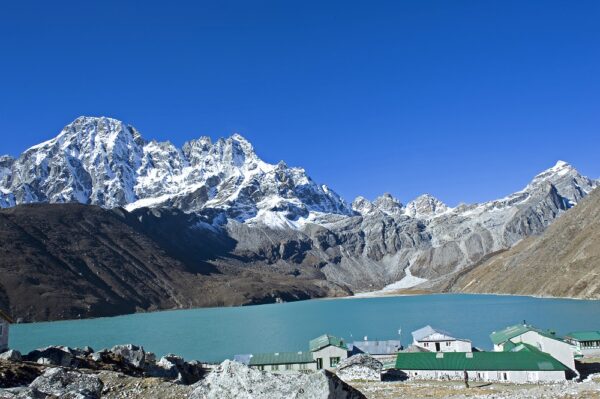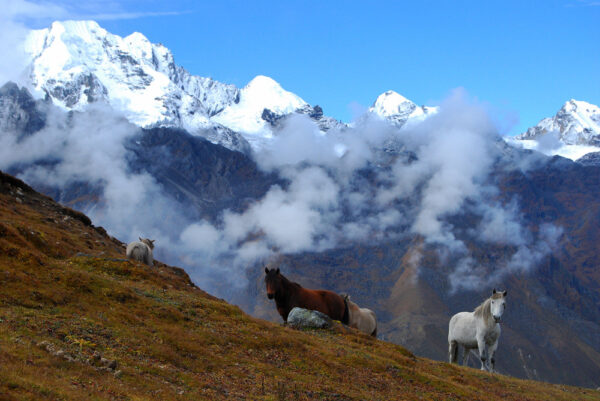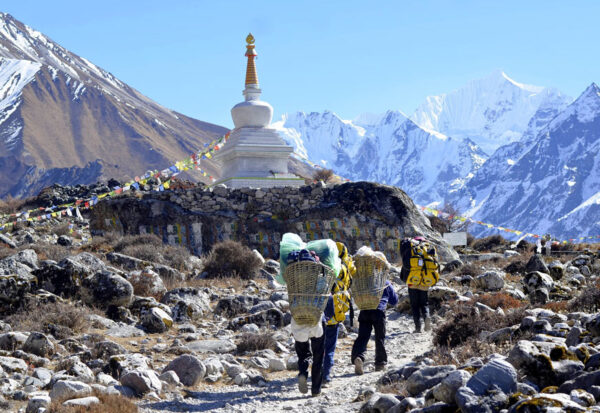-
trip code
3320
- difficulty
Moderate
-
Trip Style
Group
-
Start in
Kathmandu
-
end in
Kathmandu
-
group size
1 to 22
-
max altitude
5050m
-
Accommodation
Tea House/ Lodge
-
Best Season
Sept, Oct, Nov, March, April, May
Overview
Langtang Kyanjin Gompa Trek A Serene Himalayan Journey
The Langtang Kyanjin Gompa Trek is a stunning trek within Langtang National Park, just about an hour and a half’s drive from Kathmandu. This 10-day journey takes you through spectacular mountain views, peaceful forests, and traditional Tibetan-style villages. Along the way, you’ll visit the sacred Kyanjin Gompa Monastery and experience the rich Tamang culture that defines the region. Unlike the busier Everest or Annapurna trails, Langtang offers a quieter, more intimate experience through breathtaking Himalayan scenery.
Table of Contents
ToggleWhy Choose the Langtang Kyanjin Gompa Trek?
Compared to the Everest and Annapurna regions, Langtang sees far fewer trekkers. As a result, it’s ideal for those looking for peace, solitude, and a deeper connection with the landscape. The trail leads you through high mountain passes and glacial valleys, offering a mix of challenge and beauty. Additionally, it provides a unique window into Tibetan Buddhist culture, with prayer flags, mani walls, and monasteries dotting the route.
Whether you’re hoping to immerse yourself in nature or connect with local traditions, this trek gives you a balanced mix of both.
When to Trek: Best Seasons for Langtang Valley and Kyanjin Gompa
The best times to trek the Langtang Valley are spring (March to May) and autumn (September to November). During these months, the weather is generally clear and stable, offering panoramic views of snow-covered peaks. Moreover, spring brings vibrant rhododendron blooms, while autumn offers crisp air and clear skies—perfect conditions for photography and mountain viewing.
What to Pack for the Langtang Trek
Proper gear can make a big difference in your trekking experience. Here’s a basic list of essentials:
Clothing: Pack warm layers, including thermal wear, fleece, and a down jacket. Weather can change quickly at higher altitudes.
Footwear: Well-broken-in trekking boots with good grip are essential. Also, bring a pair of light shoes for the evenings.
Accessories: Don’t forget sunglasses, sunscreen, and a wide-brimmed hat the sun can be intense, especially at altitude.
Medications: Carry a personal first-aid kit, altitude sickness medication, and any prescriptions you might need.
Hydration: Bring reusable water bottles and water purification tablets. Staying hydrated is crucial, and bottled water may not always be available.
Additionally, a lightweight daypack, trekking poles, and a headlamp will make your journey more comfortable.
Practical Tips for a Smooth Trek
To make the most of your time in Langtang, keep these tips in mind:
Stay hydrated: Dehydration increases the risk of altitude sickness, so drink plenty of water throughout the day.
Acclimatize properly: Give your body time to adjust to the altitude. Spend an extra day at Kyanjin Gompa if needed.
Go slow: Pace yourself and take breaks. The slower you ascend, the better your chances of avoiding altitude-related issues.
Respect local culture: Greet locals politely, ask before taking photos, and follow local customs, especially when visiting monasteries.
Moreover, hiring a local guide or porter not only enhances your experience but also supports the local economy.
What Makes the Langtang Trek Special?
This 10-day trek to Kyanjin Gompa through the Langtang Valley is more than just a hike it’s a full immersion into Himalayan culture and natural beauty. You’ll cross suspension bridges, walk through ancient forests, and pass by yaks grazing in alpine meadows. As you climb higher, the landscape opens up to reveal towering peaks like Langtang Lirung, Dorje Lakpa, and Yala Peak.
Furthermore, the spiritual ambiance of Kyanjin Gompa set against a dramatic mountain backdrop—adds depth to the trek. Whether you’re lighting butter lamps in the monastery or enjoying a warm cup of yak cheese tea in a teahouse, each moment adds to the experience.
Final Thoughts: Should You Do the Langtang Kyanjin Gompa Trek?
If you’re looking for a trek that combines nature, culture, and serenity, Langtang is an excellent choice. It’s accessible, rewarding, and offers a glimpse into a part of Nepal that’s often overlooked. While the trek is moderately challenging, it’s manageable for most people in decent physical condition, especially with the right preparation.
So, if you’re planning a Himalayan adventure that avoids the crowds, consider heading to Langtang. You’ll come away with memories of quiet trails, friendly villagers, and stunning mountain views that stay with you long after the trek ends.
Start planning your Langtang Kyanjin Gompa trek today—and experience one of Nepal’s best-kept trekking secrets.
Trip highlights
It is a trek encompassing natural beauty and cultural richness. Rich green valleys, terraced fields, Langtang National Park, villages such as Kyanjin Gompa, and an ancient Buddhist monastery-most of the aspiring sights greet the trekking route. The trekkers will adore the views of Langtang Lirung, Gyangchung Kang, and several other gigantic peaks. Explore the glacial lakes close to Kyanjin for breathtaking views and opportunities to sample the local Tamang cuisine. The mighty Himalayan scenario with varied local culture has combined to turn every trekker and nature lover’s dream come true to make this trek a lifetime memory. This incredible journey offers the tranquility and beauty of the Himalayas.
itinerary
- day 1
Arrival in Kathmandu (1,400m)
- Highlights: Explore Kathmandu’s rich culture and prepare for your trek.
- Activities: Arrive at Tribhuvan International Airport, settle into your hotel, and spend the day exploring Durbar Square and Thamel. You’ll attend a pre-trek briefing in the evening.
- Overnight: Kathmandu.
- day 2
Drive from Kathmandu to Syabrubesi (1,460m)
- Distance: 7-8 hours drive.
- Highlights: Scenic drive along winding mountain roads.
- Activities: Early morning drive through terraced hills, deep valleys, and the rushing Trishuli River, arriving in the picturesque village of Syabrubesi.
- Overnight: Syabrubesi.
- day 3
Trek from Syabrubesi to Lama Hotel (2,470m
- Trek Time: 5-6 hours.
- Elevation Gain: 1,010m.
- Highlights: Walk through rhododendron forests and along the Langtang River.
- Activities: Begin your trek by crossing suspension bridges and passing small villages. As you climb higher, the trail becomes more serene, surrounded by dense forests.
- Overnight: Lama Hotel.
- day 4
Lama Hotel to Langtang Village (3,430m)
- Trek Time: 6-7 hours.
- Elevation Gain: 960m.
- Highlights: First views of Langtang Lirung (7,234m).
- Activities: Trek through pine forests and along the river as you ascend to Langtang Village, a traditional settlement rebuilt after the 2015 earthquake.
- Overnight: Langtang Village.
- day 5
Langtang Village to Kyanjin Gompa (3,870m)
- Trek Time: 3-4 hours.
- Elevation Gain: 440m.
- Highlights: Tibetan Buddhist culture and breathtaking mountain views.
- Activities: A short and scenic walk to Kyanjin Gompa, where you’ll find stunning views of surrounding peaks like Langtang Lirung and the opportunity to visit the historic monastery.
- Overnight: Kyanjin Gompa.
- day 6
Acclimatization and Exploration Day in Kyanjin Gompa
- Highlights: Climb Tserko Ri (4,984m) or visit local cheese factories.
- Activities: Spend the day acclimatizing to the altitude. You can take a day hike up to Tserko Ri for panoramic views or explore the village and sample local yak cheese at the nearby dairy farm.
- Overnight: Kyanjin Gompa.
- day 7
Trek Back to Lama Hotel
- Trek Time: 6-7 hours.
- Highlights: Retrace your steps through the stunning landscapes of Langtang.
- Activities: Begin your descent from Kyanjin Gompa to Lama Hotel, enjoying different perspectives of the Langtang Valley.
- Overnight: Lama Hotel.
- day 8
Lama Hotel to Syabrubesi
- Trek Time: 5-6 hours.
- Highlights: Relaxing descent through the Langtang River valley.
- Activities: Continue descending through forested trails back to Syabrubesi. Celebrate the end of your trek with a hearty meal and reflect on the adventure.
- Overnight: Syabrubesi.
- day 9
Drive Back to Kathmandu
- Distance: 7-8 hours drive.
- Highlights: Scenic drive back to the bustling city.
- Activities: Return to Kathmandu and spend the evening relaxing or exploring. You can also visit Boudhanath Stupa or Pashupatinath Temple.
- Overnight: Kathmandu.
- day 10
Departure
- Highlights: Farewell to Nepal.
- Activities: Depending on your flight time, you can do some last-minute shopping in Thamel or take a quick stroll through the city. Transfer to the airport for your flight back home.
Not satisfied with this itinerary?
Make your own.FAQ
-
What is the best time for the Langtang Kyanjin Gompa Trek?
Spring, from March to May, and autumn, from September to November, is the best time for doing the Langtang Kyanjin Gompa Trek because these times create optimum views due to clear skies and mild temperatures.
-
How difficult is the Langtang Kyanjin Gompa Trek?
This trek is considered to be moderately hard. Participants should be in good general shape. There are steep ascents and altitudes as high as 4,850 meters; hence, acclimatization is important.
-
What permits do I need for the Langtang Kyanjin Gompa Trek?
You will need one permit from Langtang National Park and one TIMS card. This can be obtained either in Kathmandu or at the park entrance.
-
How long does the Langtang Kyanjin Gompa Trek take?
It usually takes seven to ten days according to schedule and pace, which allows time for acclimatization and beautiful surroundings.
-
What should I pack for the Langtang Kyanjin Gompa Trek?
Basics such as trekking boots, warm clothing, a good sleeping bag, a first-aid kit, and personal things will be necessary. Sunscreen, sunglasses, and a refillable water bottle to keep hydrated during the day shouldn’t be forgotten either.
-
Is guide hire necessary for the trek?
Trekking by oneself is possible, but hiring a local guide is highly recommended because this adds immense value to knowledge of surroundings and safety, and it enhances the cultural experience.
-
What type of accommodation can I expect during the trek?
You will get teahouses right on the trail, offering basic services and local food. The accommodations vary from normal simple lodges to decent ones in Kyanjin Gompa, thus providing comfortable sleeping at the end of the long day of trekking.
Write a review
Quick enquiry
Still confused?
Talk to our expert.

Kumar Dahal
USD 699 / person
RELATED TRIPS
Sundarijal To Gosainkunda Lake Trek
Be a part of an unforgettable 11-day adventure in Nepal's most magnificent landscapes and cultural richness on the Sundarijal...
Tamang Heritage Trek
Tamang Heritage Trek is one interesting tour package that has combined some of the most breathtaking nature with the...
Langtang Valley Trek
Langtang Valley Trek was once a part of the Langtang National Park. Otherwise known as the Tamang Heritage Trail,...






